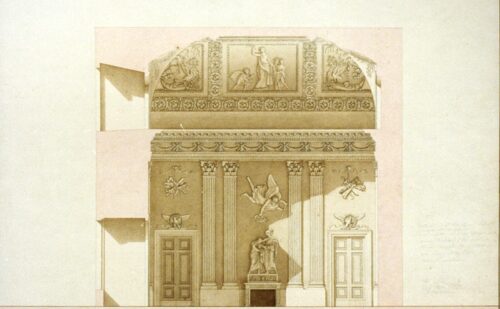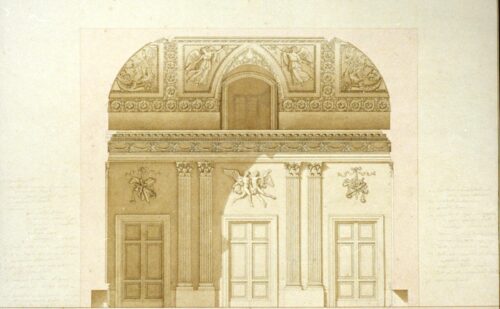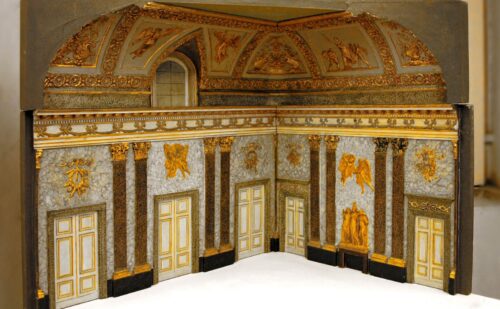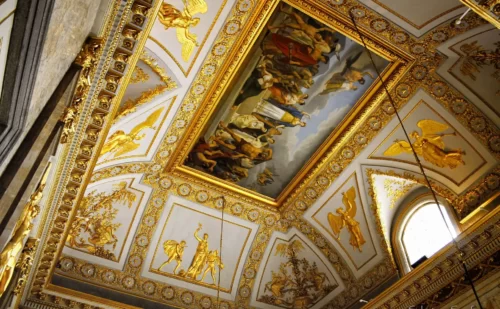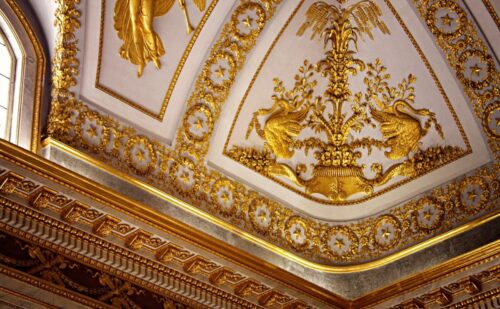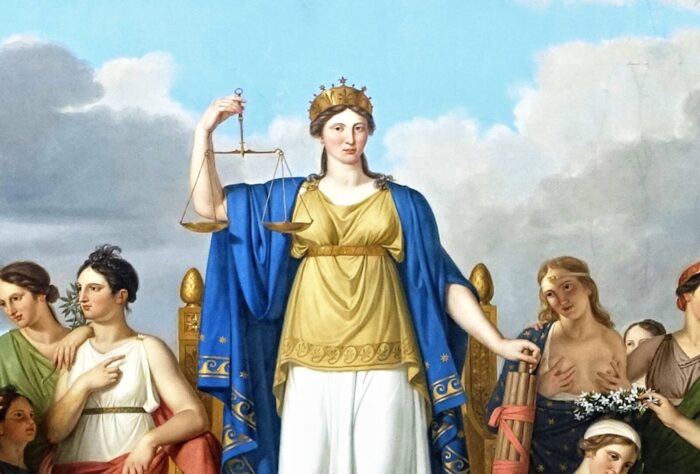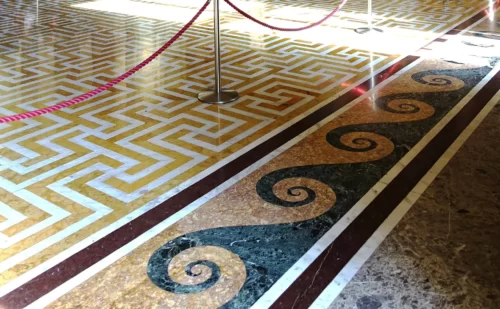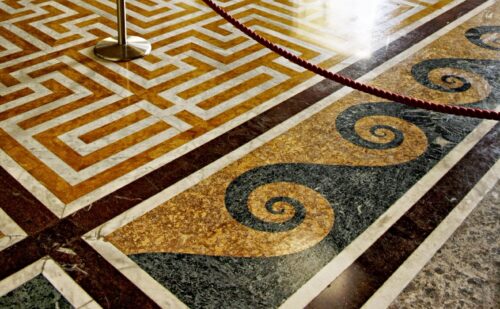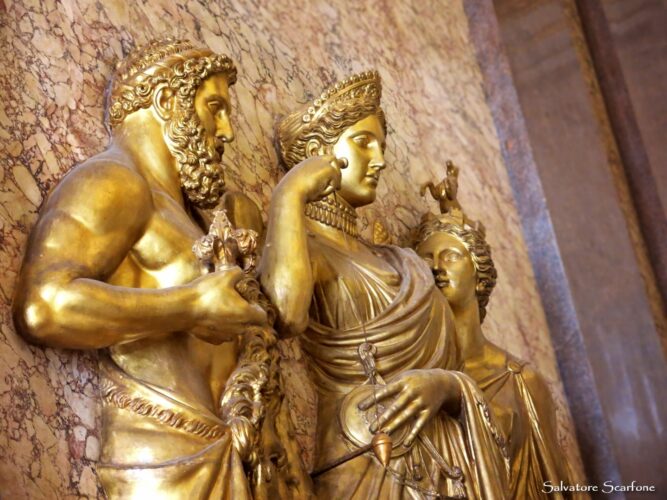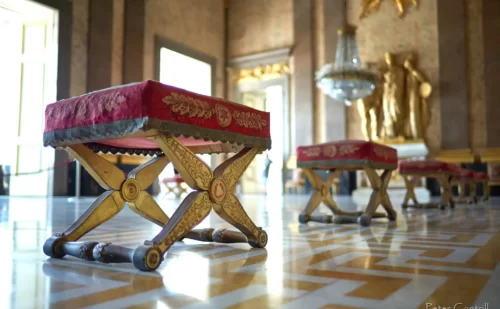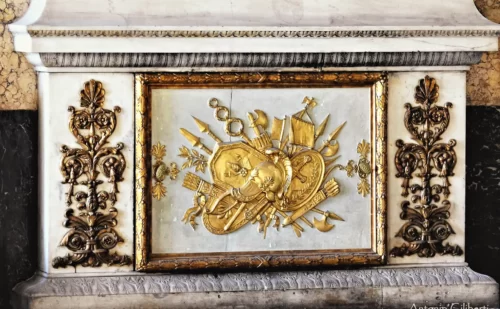The Hall of Astrea was the Antechamber of the Ambassadors
The Hall of Astrea was the antechamber of the ambassadors and gentlemen of the chamber of the Royal Palace of Caserta
Description
The Antechamber of the Ambassadors (called Hall of Astrea) in the Royal Palace of Caserta was intended for use as an Antechamber for gentlemen of the chamber, ambassadors, secretaries of state and other privileged persons. Astrea was the goddess of justice of ancient Rome.
As for the Antechamber of the Barons (called Hall of Mars), this room was also the work of the architect Antonio De Simone, and commissioned by the sovereigns Joachim Murat and Carolina Bonaparte when they were king and queen of the Kingdom of Naples.
Among the white and gold stuccoes of the vault there is the canvas with “The triumph of Astrea”, painted in 1815 by Jacques Berger (Chambery, 1754 – Naples, 1822). The two enormous fireplaces with large gilded bas-reliefs above them, and the floor, an intricate labyrinth made of marble mosaic, are very noteworthy.
The Hall of Mars and the Hall of Astrea are recognized by many as, by far, the most splendid Empire-style rooms ever created.
The project for this room was created in 1809 and two projects are kept in the San Martino Museum in Naples.
DECORATIONS AND FURNITURE OF THE Hall of Astrea
The fresco and the ceiling
This room was commissioned by the sovereigns Joachim Murat and Carolina Bonaparte when they were king and queen of the Kingdom of Naples and represent the extreme point of their artistic parable.
Among the white and gold stuccoes of the vault there is the fresco, or rather the canvas with “The triumph of Astrea”, painted in 1815 by Giacomo (Jacques) Berger, a Savoyard painter, born in Chambery in 1754 and died in Naples, in 1822. Berger was probably inspired by the founder of pictorial neoclassicism, Anton Raphael Mengs from whose Parnassus (1761) he resumed the theatrical approach. At the center of the canvas is Astrea, the goddess of Justice, smiling and pleased, seated on a cloud and surrounded by allegorical figures who are tamed by Hercules, while indicating to her father Jupiter the return of Justice to the Kingdom of Naples. In one hand she holds the scales of Justice, and in the other a fasces, which represented the power of life and death over Roman condemned men.
According to Berger’s intentions, she should have had the features of Queen Carolina: however, it is probable that, similarly to what happened with Calliano’s Mars, also for this figure the artist’s hand returned to correct the features of the face to Bourbon will, as demonstrated by the presence of small lilies on the crown.
The iconography of the royal couple of the Murat
Author: Giulio Brevetti
Within the large iconography of Gioacchino and Carolina Murat, an important place would go to the two paintings that adorn the vaults of the Sala di Marte and the Sala di Astrea in the Royal Palace of Caserta, the extreme point of their artistic parable: it is not explicitly celebratory scenes, nor of portraits tout court, but of historical-mythological episodes which for this very reason escaped the Bourbon iconoclasm, limited only to altering the faces of the two Napoleonic figures depicted at the epilogue of their rapid rise, as recalled by the archival documents.
Even if today they don’t seem to bear traces of their patrons, the Triumph of Mars and the Triumph of Justice, created simultaneously between 1812 and 1815, constitute two complex and unpublished portraits of the French royal couple: choosing to appear in the guise of a god and than an allegorical figure, the Murat spouses almost seem to adapt to those environments where their predecessors allowed themselves to be immortalized in other guises, thus betraying a desire to conform to the figurative imagery of that Ancien Régime which they had only in theory supplanted.
Walls and floor
The sculptures
In 1822, the gilded stucco reliefs with “Minerva between Legislation, Reason and Innocence” modeled by Valerio Villareale and “Astrea with Hercules and the Provinces of the Kingdom” by the Villareale and Domenico Masucci.
Valerio Villareale was certainly the best of the sculptors who worked in Caserta. Born in Palermo in 1773, he studied in Sicily with the painter Giuseppe Velasco (among the main exponents of neoclassicism) and in Rome under the guidance of Antonio Canova, from whom he learned safe and robust modeling and the classic composure of composition. At the beginning of 1812 Villareale was working on three panels for the overdoors of the Hall of Mars; later he executed two more, together with the large bas-relief in the center of the wall opposite the windows and the Victories with trophies on the smaller walls.
Together with Villareale, the sculptor D’Antonio, Claudio Monti and the aforementioned Domenico Masucci took part in the execution of the bas-reliefs.
The furnishings
External Link



